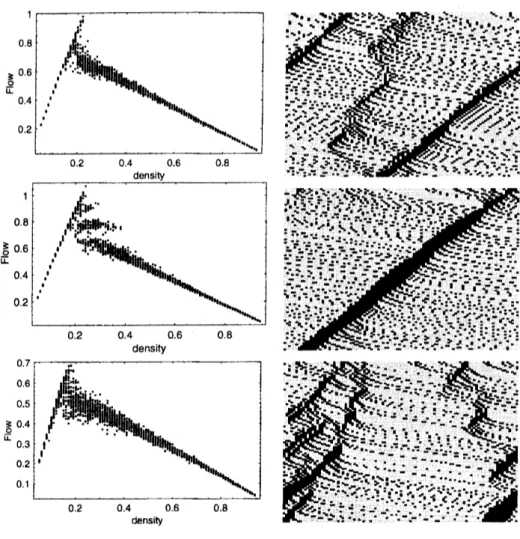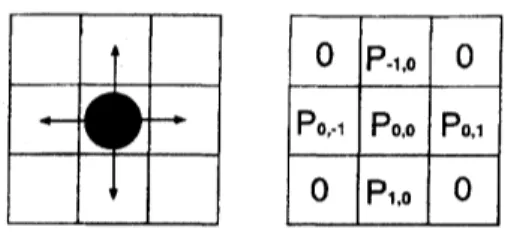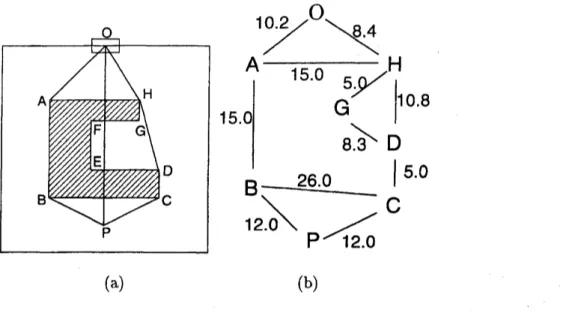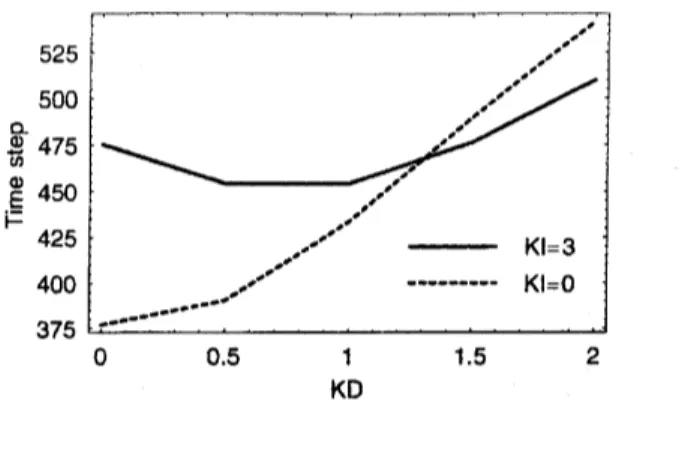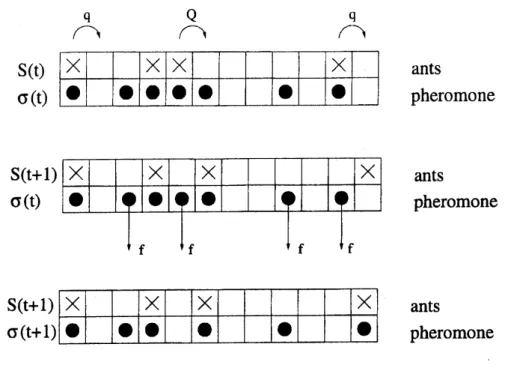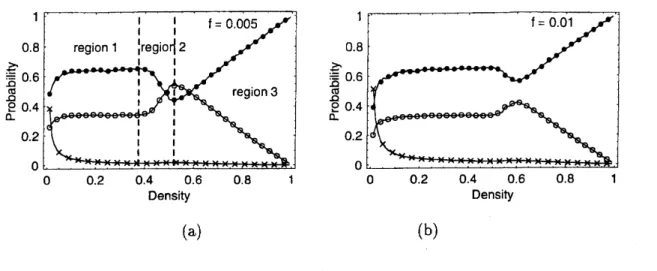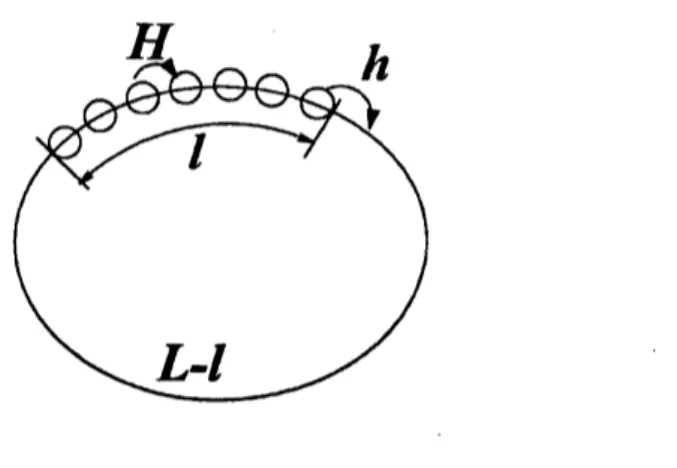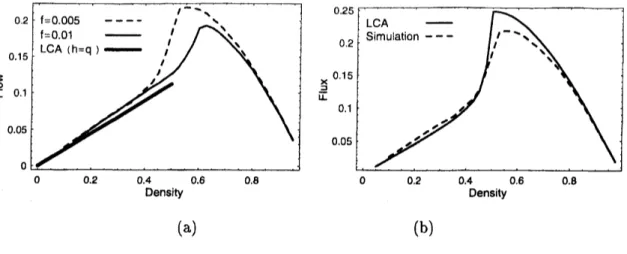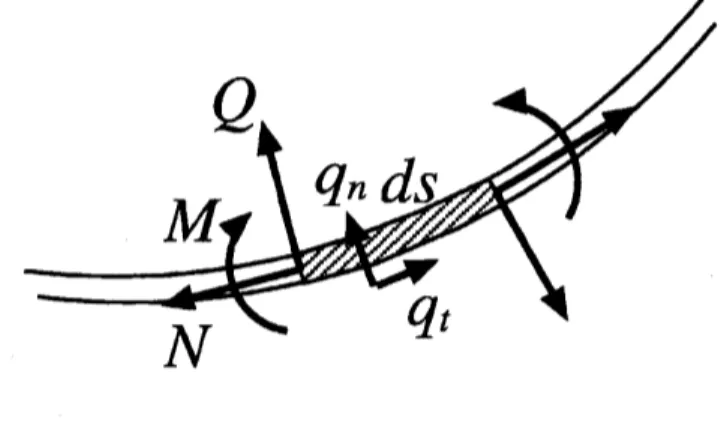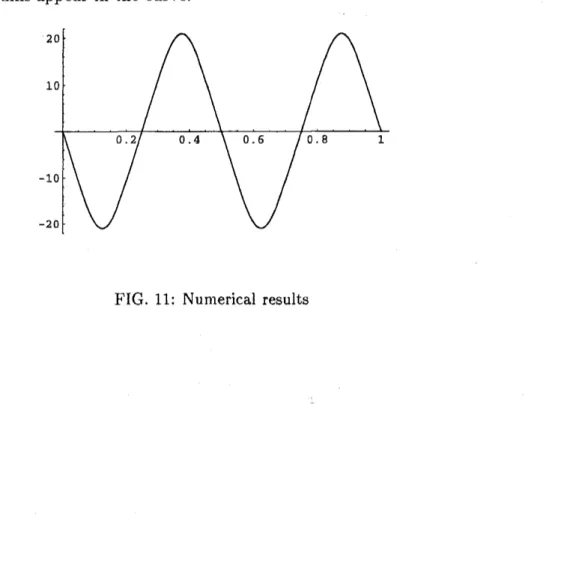Cellular automaton
analyses
on
complex systems
-from
ants to hun
an
beings-Katsuhiro Nishinari’
Department
of
Applied Mathematics and Informatics,Ryukoku University, Shiga 520-2194, Japan.
Cellular automaton modelsofcomplex systems, including vehicular traffic,
pedes-trian flow and ant trail are presented in this paper. Similarities and differences
between these models are discussed by using the fundamental diagram, i.e., the
flow-density relation. In the vehicular traffic there exists metastable branches near
the critical density. It is shown that the ant model shows an anomalous behaviour
due to the existence of pheromone. In appendix, an application of the Painleve
equation is discussed.
I. INTRODUCTION
Particle-hopping models have been used widely in the recent years to study the
spati0-temporal organization in systems of interacting particles driven far from equilibrium [1].
Oftensuch models are formulated in terms of cellular automata (CA) [2]. Examples of such
systems include vehicular traffic and pedestrian flow [3-5] where their mutual influence is
captured by the inter-particleinteractions. Usually, these inter-particleinteractions tend to
hinder their motions so that the average speed decreases monotonically with the increasing
densityofthe particles. In arecentletter [6] we have reported a counter-example, motivated
by the flux of ants in a trail [7], where, the
average
speed of the particles variesnon-monotonically with their density because of the coupling of their dynamics with another
dynamical variable.
In this paper, we show cellular automaton models of vehicular traffic, pedestrian flow
and ant trail, and discuss similarities and differences between these models by using the
fundamental
diagram, i.e., theflow-density relation.
Electronic address: knishiQrins ryukoku
.
$\mathrm{a}\mathrm{c}$.
jpII. VEHICLE TRAFFIC MODEL
Recently, cellular automata (CA) have been extensively used for modeling complex
phe-nomena in various fields such as fluid dynamics, statistical physics, biology and other
com-plex systems[l]. Among these $\mathrm{C}\mathrm{A}$, the rule-184 $\mathrm{C}\mathrm{A}$, which is one of the elementary CA
(ECA) proposed by Wolfram[2], has attracted much attention as a model of dynamics of
interface[8] and
traffic
flow$[9, 10]$. For the model of traffic flow, the rule-184CA
is known torepresent the minimal model for movement of vehicles in one lane and show
a
simple phasetransition from free to congested state of traffic flow[3].
In the previouspaper[l1], by using the ultra-discrete method [12], theBurgers $\mathrm{C}\mathrm{A}(\mathrm{B}\mathrm{C}\mathrm{A})$
has been derivedfrom the Burgers equation $\rho_{t}=$ 2ppx $+\rho_{xx}$ which was used by Musha et $al$
as a macroscopic traffic m0de1[4][13]. BCA is written as
$U_{j}^{t+1}=U_{j}^{i}+ \min(U_{j-1}^{t}, L-U_{j}^{t})-$$\min(Uj, L-U_{j+1}^{t})$, (1)
where $U_{j}^{t}$ denote the number of vehicles at the site$j$ and time$t$. The parameter $L$ represents
the maximumcapacity ofa cell and is related to thelattice interval ofthe spatialcoordinate
$x[11]$
.
Putting the restriction $L=1$ on (1),BCA
is found to be equivalent to the rule-184$\mathrm{C}\mathrm{A}$,which is a prototype ofthe microscopictrafficmodels[10].
Since
theBurgers equation isconsideredto bethe 1-dimensional Navier-Stokesequation, it is natural to saythat (1) is the
Euler representationoftrafficflow. In the Euler description,flow is observed at certain fixed
point in space and a dependent variable represents the amplitude of a field at that point.
It is noted that the above result has clarified the fact that there is a rigorous the relation
between a macroscopic traffic model and
a
microscopicone
inthe
Euler representation viathe ultra-discrete method.
There is the other representation called Lagrange representation, which originally also
comes
from hydrodynamics. In this representation, we observe each particle and followthe trajectory of it. Then we would like to propose the Euler-Lagrange transformation by
developingnew explicit transformation formulas containing the $\max$ and step function, and
First we introduce the variable $n$ by
$S_{j}^{i}= \sum_{k=-\infty}^{J}u_{k}^{t}$.,
$U_{j}^{t}=u_{Lj+1}^{t}+u_{Lj+2}^{t}+\cdots+u_{L(j+1)}^{t}$
$=S_{L(j+1)}^{t}-\llcorner \mathrm{b}_{L_{J}}^{\gamma t}$, $(\underline{.?})$
where $u_{j}^{t}$ denotes the number of vehicles whose value is zero or one at $j$ th site at time $t$.
Substituting (2) into (1), we obtain
$S_{Lj}^{t+1}= \max(S_{L(j-1)}^{t}, S_{L(j+1)}^{t}-L)$. (3)
Replacing $Lj$ by$j$, this becomes,
$S_{j}^{t+1}= \max(S_{j-L}^{t}, S_{j+L}^{t}-L)$. (4)
Note that ifwe put $S_{j}^{t}=F_{j}^{t}+ \frac{j}{2}-\frac{Lt}{2}$, this becomes the ultra discrete diffusion equation, $F_{j}^{t+1}= \max(F_{j-L}^{i}, F_{\mathrm{j}+L}^{t})$
.
(5)Here, we put
$S_{j}^{t}= \sum_{i=0}^{N-1}H(j-x_{i}^{t})$, (6)
where $H(x)$ is the step function defined by $H(x)=1$ if$x\geq 0$ and $H(x)=0$ otherwise, and
$N$ is the total number of vehicles on the road. $x_{i}^{t}$ is the Lagrange variable that represents
the position ofthe$i$-th car at time$t$ and, of course, the relation $x_{0}^{t}<x_{1}^{t}<$ $<x_{N-1}^{t}$ holds.
By using the newly proposed formula
$\sum_{k=1}^{n}H(j-\min(a_{k}, b_{k}))=\max(\sum_{k=1}^{n}H(j-a_{k}),$$\sum_{k=1}^{n}H(j-b_{k}))$ , (7)
where we assume $a_{1}<a_{2}<$ $<a_{n}$ and $b_{1}<b_{2}<$ $<b_{n}$, we obtain the Lagrange form
of
BCA
with general $L$ as$x_{i}^{t+1}=x_{i}^{t}+ \min(L, x:_{+L}-x_{i}^{t}-L)$. (8)
Theformula(7) expressesthe commutability of$\max$function and step function whichallows
us to manipulate Lagrange variables, and hence it is considered to be afundamental formula
4
We should note here that the derived equation (8) is a
special case
of$x_{i}^{t+1}\backslash =x_{i}^{t}+\mathrm{l}\mathrm{n}\mathrm{i}\mathrm{n}(\mathrm{I}\prime^{\Gamma}, x_{i+S}^{t}-x_{i}^{t}-S)$, (9)
where $V$ and $S$ are
parameters
and $V\neq S$ in general. This equation contains theFukui-Ishibashi
mode1[10]and
the quick-t0-start m0de1[14] as specialcases
by putting $S=1$ and$V=1,$ respectively, thus it is considered as a generalization of these
CA
models of trafficflow.
Next we will combine the above model with the
NS
model in order to take into accountthe randomness of drivers. The
NS
model is written in Lagrange form as$x_{i}^{t+1}=x_{i}^{t}+ \max(0,\min(V, x_{i+1}^{t}-x_{i}^{t}-1, x_{i}^{t}-x_{i}^{t-1}+1)-\eta_{i}^{t})$. (10)
where $\eta_{j}^{t}=1$ with probability $p$ and $\eta_{i}^{t}=0$ with probability 1 – $p$
.
The last term inthe mininum in (10) represents the acceleration of cars. The randomness in this model
is considered as a kind of random braking effect, which is known to be responsible for
spontaneous jam formation often observed in real traffic [3]. We also consider random
accerelationinthismodelwhich is not takeninto account in theNS model. Thus astochastic
generalization is given in the following set ofrules:
1 Random accerelation
$v_{i}^{(1)}= \min(V_{\max}, v_{i}^{(0)}+\eta_{u})$
.
(10)where $\eta_{a}=1$ with the probability$p_{a}$ and $\eta_{a}=0$ with $1-p_{a}$.
2 Slow-tO-start
effect
$v_{i}^{(2)}= \min(v_{i}^{(1)}, x_{i+2}^{t-1}-x_{i}^{t-1}-2)$
.
(12)3 Deceleration due to other vehicles
$v_{i}^{(3)}= \min(v_{i}^{(2)}, x_{i+2}^{t}-x_{i}^{i}-2)$. (13)
4 Random braking
$v_{i}^{(4)}= \min(v_{i}^{(3)}-\eta_{b}, 0)$ (14)
5
5 Avoidance
of
collision$v_{i}^{(n+1)}=\mathrm{l}\mathrm{n}\mathrm{i}\mathrm{n}(v_{i}^{(n)}, x_{\mathrm{i}+1}^{t}-x_{i}^{t}-1+v_{i+1}^{(n)}.)$ (15)
with $l?\geq 4,$ which is an iterative equation that has to be applied until /7 converges to $\iota^{(n+1)}J_{i}=v_{i}^{(n)}(\equiv v_{i})$.
6 Vehicle movement
$x_{i}^{t+1}=x_{i}^{t}+v_{j}$. (16)
Again the velocity $v_{i}$ is used
as
$v_{i}^{(0)}$ in the next time step. Step 5 must be applied to eachcar iteratively until its velocitydoes not change any more, which ensures that this modelis
free from collisions. The fundamental diagrams of this stochastic model for some values of
$p_{a}$ and $p_{b}$ are given in Fig. 1. We seesomemetastablebranches in thefundamental diagram.
Moreover,from the spati0-temporal pattern spontaneous jamformationisobserved only if we
allow random braking. Random accerelation alone is not sufficient to produce spontaneous
jamming formation. We also note that a wider scattering area appears if we introduce both
random accerelation and braking.
III. PEDESTRIAN TRAFFIC MODEL
Recent progress in modelling pedestrian dynamics [15] is remarkable and many valuable
results are obtained by using different models, such as the social force model [16] and the
floor field model $[8, 17]$
.
The former model is based on a system of coupled differentialequations which has to be solved e.g. by using a molecular dynamics approach similar to
the studyof granular matter. Pedestrian interactions are modelled via long-ranged repulsive
forces. In the latter model two kinds of floor fields, i.e., a static and a dynamic one, are
introduced
to translatea long-ranged
spatial interaction intoan
attractive local interaction,but
with
memory, similar to the phenomenon ofchemotaxis in biology [18]. It is interestingthat, even though these two models employ different rules for pedestrian dynamics, they
share many properties including lane formation, oscillations of the direction at bottlenecks
[17], and the s0-called faster-is-slower effect [16]. Although these are important basics for
pedestrian modelling, there are still many things to be done in order to apply the models
FIG. 1: Fundamental diagrams and typicalspati0-temporal patternsof the newstochastic Lagrange
model with different value of random parameters. Parameters are set to $V_{\max}=5$ and $S=2.$
Upper two figures are the case of$p_{a}=0$ and $pb$ $=0.2,$ middle ones are$p_{C1}=0.8$ and $pb=0,$ and
the bottom ones are$p_{a}=0.8$ and $pb$ $=0.2.$
this paper, we will propose a method to construct the staticfloor field for complex rooms of
arbitrary geometry. The static floor field is an important ingredient of the model and has
to be specified before the simulations.
First
we
show the update rules of anextended
floorfield
model for modelling panicbehavior ofpeople evacuatingfrom a
room.
The space is discretizedinto cells ofsize 40cm
$\cross$$40$cm which can either beempty or occupied by one pedestrian (hard-core-exclusion). Each
pedestrian
can move
to one of theunoccupiednext-neighborcells $(i,j)$ (orstay at thepresentcell) at each discrete time step $tarrow t1$ $1$ according to certain transition probabilities
$p_{ij}$
7
0 $\mathrm{P}.\iota$ 0
$\mathrm{P}_{0}$. Po. $\mathrm{p}_{0.\tau}$
$0$ $\mathrm{P}\tau.0$ 0
FIG. 2: Target cells for a person at the next time step. The von Neumann neighborhood is used
for this model.
For the caseof evacuation processes, the static
floor field
$S$describesthe shortest distanceto
an
exit door. The field strength $S_{ij}$ is set inversely proportional to thedistance
from thedoor. The dynamic
floor field
$D$ is a virtual trace left by the pedestrians similar to thepheromone in chemotaxis [19]. It has its own dynamics, namely diffusion and decay, which
leads to broadening, dilution and finally vanishing of the $\mathrm{t}\mathrm{r}\mathrm{a}\mathrm{c}\mathrm{e}$. At $t=0$ for all sites
$(i,j)$
of the lattice the dynamic field is zero, i.e., $D_{ij}=0.$ Whenever a particlejumps from site
$(i,j)$ to
one
of the neighboring cells, $D$ at the origin cell is increased by one.Themodelis able to reproduce various fundamental phenomena, such as lane formation in
a corridor, herding and oscillation at a bottleneck $[8, 17]$. This is an indispensable property
for any reliable model ofpedestrian dynamics, especially for discussing safety issues.
A. Basic update rules
The update rules of our CA have the following structure:
1. The dynamic floor field $D$ is modified according to its diffusion and decay rules,
con-trolled by theparameters$\alpha$ and $\delta$
.
In eachtimestepof thesimulation each single bosonof the whole dynamic field $D$ decays with probability $\delta$ and diffuses with probability
$\alpha$ to one of its neighboring cells.
2. For eachpedestrian, thetransition probabilities$p_{ij}$ for amoveto
an
unoccupiedneigh-bor cell $(i, j)$ are determined by the two floor fields and one’s inertia (Fig. 2). The
values ofthe fields $D$ (dynamic) and $S$ (static)
are
weighted with two sensitivitypa-rameters $k_{D}$ and $k_{S}$:
with theno rnalization $N$
.
Here$p_{I}$ represents the inertia effect [17] given by$p_{I}(i,j)=$ $\exp(k_{I})$ for the direction of one’s motion in the previous time step, and $p_{I}(i,j)=1$for other cells, where $f\hat{\iota}I$ is the sensitivity parameter. $p\mathfrak{s}v$ is the wall potential which is
explained below. In (17) we do not take into account the obstacle cells (walls etc.) as
well as occupied cells.
3. Each pedestrian chooses randomly a target cell based
on
the transition probabilities$Pij$
determined
by (17).4. Whenever two or more pedestrians attempt to move to the
same
target cell, themove-ment of all
involved
particles is denied with probability $\mu\in[0,1]$, i.e.all
pedestriansremain at their site [20]. This means that with probability $1-\mu$
one
of the individualsmovesto the desired cell. Whichone is allowed tomove is decided using aprobabilistic
method $[17, 20]$
.
5. The pedestrians who are allowed to move perform their motion to the target cell
chosen in step
3.
$D$ at the origin cell $(i, 7)$ of each moving particle is increased byone:
$D_{ij}arrow D_{ij}+1,$ i.e. $D$ can take any non-negative integer value.
The above rules are applied to all pedestrians at the same time (parallel update).
Some
important details
are
explained in the following subsections.B. Effect of walls
Peopletend to avoid walking closeto walls andobstacles. This can be taken into account
by using “wall
potentials”
-We introduce
a repulsive potential inverselyproportional to thedistance from the walls. The effect ofthe static floor field is then modified by a factor (see
eq. (17)$)$:
$p_{W}= \exp(k_{W}\min(D_{\max}, d))$, (18)
where $d$ is theminimumdistance from all the walls, and $kw$ is a sensitivityparameter. The
$\mathrm{o}$ $\mathrm{H}$ $\mathrm{A}$ $\nearrow \mathrm{E}\mathrm{F}$ $\mathrm{G}$ $\mathrm{D}$ $\mathrm{B}$ $\mathrm{c}$ $\mathrm{P}$ $10.2\nearrow^{\mathrm{O}}\backslash 8.4$
A
$-\mathrm{H}$
15.0 $15.0|$ $\mathrm{G}8.35.\backslash \mathrm{D}|10.8$26.0
$|5.0$ $\mathrm{B}12.0\backslash \mathrm{P}1$ $\mathrm{C}$ (a) (b)FIG. 3: Example for the calculation of the static floor field using the Dijkstra method, (a) A
room with one obstacle. The door is at $O$ and the obstacle is represented by lines $\mathrm{t}$ –H. (b)
The visibility graph for this room. Each node connected by a bond is
“visible”:
i.e., there are noobstacles between them. The real number on each bond represents the distance between them as
an illustration.
C. Calculation of the static field in arbitrary geometries
In thefollowing we propose a combination of the visibility graph and Dijkstra’s algorithm
to calculate the static floor field. These methods enable us to determine the minimum
Euclidian $(L^{2})$ distanceof any cell to a door with arbitrary obstacles between them.
Let us explain the main idea of this method by using the configuration given in Fig. $3(\mathrm{a})$
where there isanobstaclein themiddleoftheroom. We will calculate the minimumdistance
between a cell $P$ and the door $O$ by avoiding the obstacle. If the line $PO$ does not cross the
obstacle $A-H,$ then the length of the line, ofcourse, gives the minimum. If, however, asin
the example given in Fig. $3(\mathrm{a})$, the line $PO$ crosses the obstacle, one has to make a detour
around it. Then we obtain two candidates for the minimum distance, i.e., lines
PBAO
andPCDHO.
The shorter one finally gives the minimum distance between $P$ and $O$.
Ifthereare more than one obstacle in the room, then we apply the
same
procedure to each ofthemrepeatedly. Here it is important to note that all the lines pass only the obstacle’s edges with
an acute angle. It is apparent that the obtuse edges like $E$ and $F$ can never be passed by
10
To incorporate this idea into the computerprogram, wefirst need the concept of the
vis-ibility graph in which only the nodes that are visible to each other are bonded [21] ( visible
means here that there are no obstacles between them). The set of nodes consists of a cell
point $P$, a door $O$ and all the acute edges in the
room.
In the case of Fig. $3(\mathrm{a})$, the nodeset is $\{P, O, A, B, C, D, G, H\}$ and the bonds are connected between $A-B$, $A-H,$ and so
on
(Fig. $3(\mathrm{b})$).Each bond has
its ownweight
which corresponds to the Euclidian distancebetween them.
Once
we have the visibility graph, we can calculate the distance between $P$ and0
bytracing and adding the weight ofthe bonds between them. There are several possible paths
between $P$ and 0, and the
one
with minimum total weight represents the shortest routebetween them. The optimization task is easily performedby using the Dijkstramethod [21]
which enables us to obtain theminimum path on a weighted graph.
Performing this procedure for each cell in the room, the method allows us to determine
the
static
floor field for arbitrarygeometries.
D. Simulations: Inertia effect
We focus on measuring the total evacuation timeby changing the parameters $ks$,$f_{\vee D}^{n}$,$k_{I}$, $\mu$
and theconfiguration of theroom, such as width, position and number of doors and obstacles.
In allsimulations we put $D_{\max}=10$, $\alpha=0.2$ and $\delta=0.2,$ and von Neumann neighborhoods
are used in eq. (17) for simplicity. The sizeofthe room is set to 100 $\cross 100$ cells. Pedestrians
try to keep their preferred velocity and direction
as
long as possible. Thisis taken
intoaccount by adjusting the parameter $k_{I}$
.
In Fig. 4, total evacuation times from a roomwithout any obstacles are shown as function of $k_{D}$ in the cases $k_{I}=0$ and $k_{I}=3.$ We
see that it is monotonously increasing in the case $k_{I}=0,$ because any perturbation from
other people becomes large if$f_{\vee D}^{\wedge}$ increases, which causes the deviation from the minimum
route. Introduction of inertia effects, however, changes this property qualitatively
as
seen
in Fig. 4. The minimum time appears around $k_{D}^{\wedge}=1$ in the case $k_{I}=3.$ This is well
explained by taking into account the physical meanings of $k_{I}$ and $k_{D}$. If $f_{\vee I}^{\wedge}$ becomes large,
people become less
flexible
and all of them try to keep their ownminimum
route tothe
exitaccording to the static floor field regardless of congestion. By increas$\mathrm{i}_{1\mathrm{l}}\mathrm{g}k_{D}$, one begins to
11
$\Phi \mathrm{f}D\Phi 0_{-}$
KD
FIG. 4: Total evacuation time versus coupling $k_{D}$ to the dynamic floor field in the dependence of
$k_{I}$
.
The room is a simple square without obstacles and 50 simulations are averaged for each datapoint. Parameters are $\rho=0.03$,$ks=2$,$kw=0.3$ and $\mathrm{p}$ $=0.$
makes one flexible and hence contributes to avoid congestion. Large $k_{D}$ again works as
strong perturbation as in the case of $k_{I}=0,$ which diverts people from the shortest route
largely. Thus we have the minimum time at a certain magnitude of $k_{D}$, which will depend
on the value of $k_{s}$ and $k_{I}$.
$\mathrm{I}\mathrm{V}$
.
ANT TRAIL MODELThe ants communicate with each other by dropping a chemical (generically called
pheromone) on the substrate as they crawl forward $[19, 22]$. Although we cannot smell
it, the trail pheromone sticks to the substrate long enough for the other following
sniff-ing ants to pick up its smell and follow the trail. Ant trails may serve different purposes
(trunk trails, migratory routes) and may also be used in a different wayby different species.
Therefore one-way trails are observed as well as trails with counterflow ofants.
In [6] we developed a particle-hopping model, formulated in terms of stochastic CA [2],
which may be interpreted as a model of unidirectional flow in an ant-trail. As in ref. [6],
rather than addressing the question of the
emergence
of the ant-trail, we focus attentionhere on the traffic of ants on a trail which has already been formed. Furthermore we have
assumed unidirectional motion. The effects of counterflow, which are important for some
species, will be investigated in the future.
12
$\cap^{9}$ $\cap \mathrm{Q}$ $r^{\mathrm{q}}\backslash$
$\mathrm{S}(\mathrm{t})$ ants $\sigma(\mathrm{t})$ pheromone ants pheromone ants pheromone
FIG. 5: Schematic representation of typical configurations; it also illustrates the update procedure.
Top: Configuration at time $t$, i.e.
before
stage I of the update. The non-vanishing hoppingprob-abilities of the ants are also shown explicitly. Middle: Configuration
after
one possible realisationof stage $I$. Two ants have moved compared to the top part of thefigure. Also indicated are the
pheromones that may evaporate in stage $II$ of the update scheme. Bottom: Configuration
after
one possible realization of stage II. Two pheromones have evaporated and one pheromone has
been created due to the motion ofan ant.
at most one ant at a time (see Fig. 5). The lattice sites are labelled by the index $i$
$(i=1,2, \ldots, L);L$ being the length of the lattice. We associate two binary variables $S_{i}$
and $\sigma_{i}$ with each site
$i$ where Si takes the value 0 or 1 depending on whether the cell is
empty or occupied by an ant. Similarly, $\sigma_{i}=1$ if the cell $i$ contains pheromone;
other-wise, $\sigma_{i}=0.$ Thus, we have two subsets of dynamical variables in this model, namely,
$\{S(t)\}\equiv(S_{1}(t), S_{2}(t)$,$\ldots$:$S_{j}(t)$,$\ldots$,$S_{L}(t))$ and $\{\sigma(t)\}\equiv(\sigma_{1}(t), \sigma_{2}(t)$, $\ldots$:
$\sigma_{i}(t)$,
$\ldots$,$\sigma_{L}(t))$. The
instantaneous state (i.e.,the configuration) of the system at any time is specified completely
by the set $(\{S\}, \{\sigma\})$.
Since a unidirectional motion is assumed, ants do not move
backward.
Theirforward-hopping probability is higher if it smells pheromone ahead ofit. The state of the system is
updated at each time step in two stages. In stage I ants are allowedto
move.
Here the subset13
time $t$.
Stage
II corresponds to the evaporation ofpheromone.Here
onlythe subset
$\{\sigma(t)\}$is updated so that at the end of
stage
II the new configuration $(\{S(t+1)\}, \{\sigma(t+-1)\})$ attime $t+1$ is obtained. In each stage the dynamical rules are applied in parallel to all ants
and pheromones, respectively. Stage $I$: Motion
of
antsAn ant in cell $i$ that has an empty cell in front of it, i.e., $S_{i}(t)=1$ and
$S_{i+1}(t)=0,$ hops forward with probability $=\{$ $Q$ if $\sigma_{i+1}(t)=1,$ $q$ if $\sigma_{i+1}(t)=0,$ (19)
where, to be consistent with real ant-trails, we assume $q<Q.$
Stage $II.\cdot$ Evaporation
of
pheromonesAt each cell $i$ occupied by an ant after stage I a pheromone will be created, i.e.,
$\sigma_{i}(t+1)=1$ if $\mathrm{S}_{\acute{\mathrm{i}}}(t+1)=1.$ (20)
On
the other hand, any ‘free’ pheromone at a site $i$ not occupied by an ant will evaporatewith the probability $f$ per unit time, i.e., if $S_{i}(t+1)=0$, $\sigma_{\dot{\mathrm{a}}}(t)=1,$ then
$\sigma_{i}(t+1)=\{$ 0 with probability
$f$,
1 with probability $1$
-f.
(21)
Note that the dynamics conserves the number $N$ of ants, but not the number of
pheromones.
The
rules can
be written in a compact formas
the coupled equations$S_{j}(t+1)=S_{j}(t)+ \min(\eta j-1(t), Sj-1(t),$$1-Sj(t))$
$- \min(\mathrm{t}\mathrm{X}\mathrm{j}(t), S_{j}(t)$, $1-Sj+1(t))$, (22)
$\sigma j(t+1)=\max(Sj(t+1),\min(\sigma j(t), \xi j(t)))$, (23)
where $\xi$ and
7 are stochastic variables defined by $\mathit{5}j(t)$ $=0$ with the probability $f$ and
$\xi j(t)=1$ with l-f, and $\eta j(t)=1$ with the probability$p=q+(Q-q)\sigma j+1(t)$ and $\eta j(t)=0$
14
$\mathrm{L}\mathrm{D}\mathrm{D}\iota \mathrm{u}$ $\ovalbox{\tt\small REJECT}^{\mathrm{t}\mathrm{r}\{}$ $\mathrm{n}\varpi\frac{D}{\mathrm{L}}$ $\ovalbox{\tt\small REJECT}$ (a) (b)FIG. 6: Numerical results for the probabilities offinding an ant(o), pheromone but no ant(o) and
nothing(x) in front ofan ant are plotted against density of the ants. The parametersare $f=$0.005
(in (a)) and $f=0.01$ (in (b)).
A. “Loose” cluster approximation (LCA)
Let us consider again the probabilities $Pa$, $P_{p}$, $P_{0}$ defined in the previous section. For
the purpose of clarifying some subtle concepts of “clustering” we replot these probabilities
for only two specific values of $f$ in Fig. 6; these
data
have been obtained from computersimulations of our ant-trail model.
There is a flat part of the curves in Fig. 6 in the low density regime; from now onwards,
we shall referto this region as “region 1”. Note that in this region, in spite of low density of
the ants, the probability offinding an ant infront of another is quitehigh. This implies the
fact that ants tend to form a cluster. On the other hand, cluster-size distribution, obtained
from ourcomputer simulations, shows that the probability offinding isolated ants arealways
higher than that of finding a cluster of ants occupying nearest-neighbor sites[23].
These two apparently contradictory observations can be
reconciled
by assuming that theants form “loose” clusters in the region 1. The term “loose” meansthat there are smallgaps
in between successive ants in the cluster, and the cluster looks likean usual compact cluster
ifit is seen from a distance (Fig. 7). In other words, a loose cluster isjust a loose assembly
of isolated ants. Thus it corresponds to a space region with densitylarger than the average
density $\rho$, but smaller than the maximal density $(\rho=1)$ of a compact cluster.
1
$\mathrm{s}$FIG. 7: Schematic explanation of the loose cluster. $H$is the hopping probability of ants inside the
loose cluster and $h$ is that of the leading ant.
Then the hopping probability of all the ants, except the leading one, is assumed to be $H$,
while that of the leading one is $h$ (see Fig. 7); the values of $H$ and $h$ are determined
self-consistently. Before
beginning
the detailed analysis, letus
consider the properties of $H$ and$h$. If $f$ is small enough, then $H$ will be close to $Q$ because the gap between ants is quite
small. On the other hand, if the density of ants is low enough, then $h$ will be very close to
$q$ because the pheromone dropped by the leading ant would evaporate when the following
ant arrives there.
Next we determine the typical size ofthe gap between successive ants in the cluster. We
will estimate this by considering a simple time evolution beginning with an usual compact
cluster (with local density $\rho=1$) without any gap in between the ants. Then the leading
ant willmove forward by one site overthe timeinterval $1$/h. This hopping occurs repeatedly
and in the interval of the successive hopping, the number of the following ants which will
move one step is $H/h$. Thus, in the stationary state, strings (compact clusters) of length
$H/h$, separated from each other by one vacant site, will produced repeatedly by the ants
(see Fig. 8). Then the average gap between ants is
$\frac{(\frac{H}{h}-1)\cdot 0+11}{H/h}=\frac{h}{H}$, (24)
which is independent of the density $\rho$ of ants. Interestingly, the density-independent
aver-age gap
in theLCA
is consistent with the flat part (i.e.,region
1) observed in computersimulations (Fig. 6). In other words, the region 1 is dominated by loose clusters.
18
$\mathrm{O}$ $\mathrm{O}$
FIG. 8: The stationary loose cluster. The average gap between ants becomes $h/H$, which is
irrelevant to the density of ants.
hopping probability of leading ants becomes large and the
gap
becomes wider,which
willincrease the flow. We call this region as region 2, in which the “looser” cluster is formed in
the stationarystate. It can becharacterizedby anegative gradient of the density dependence
of the probability to find an ant in front of a cell occupied by an ant (see Fig. 6).
Considering thesefacts, we finallyobtain the following equations for $h$ and $H$:
$( \frac{h-q}{Q-q})^{h}=(1-f)^{L-l}$, $( \frac{H-q}{Q-q})^{H}=(1-f)^{\frac{h}{H}}$, (25)
where
1
is the length of the cluster given by$l= \rho L+(\rho L-1)\frac{h}{H}$, (26)
and $\rho$ and $L$ are density and the system size, respectively. These equations can be applied
to the region 1 and $\underline{?}$, and solved simultaneously by the Newton method.
Total flux in this system is then calculated as follows. The effective density peff in the
loose cluster is given by
$\rho_{\mathrm{e}\mathrm{f}\mathrm{f}}=\frac{1}{1+h/H}$
.
(27)Therefore, considering the fact that there are no ants in the part of the length $L-l,$ total
flux $F$ is
$F=$
;
$f(H, \mathrm{t}_{\mathrm{e}\mathrm{f}\mathrm{f}})$, (28)where $f(H,\rho_{\mathrm{e}\mathrm{f}\mathrm{f}})$ is given by
$f(H, \rho_{\mathrm{e}\mathrm{f}\mathrm{f}})=\frac{1}{2}(1-\sqrt{1-4H_{\beta \mathrm{e}\mathrm{f}\mathrm{f}}(1-\rho_{\mathrm{e}\mathrm{f}\mathrm{f}})})$ (29)
Above the density 1/2, ants are assumed to be uniformly distributed, in which a kind of
MFA works well. We call this region as region
3.
Thus we have three typical regions in this17
u-2$\mathrm{A}2$
$//’/r’$ IL $\mathrm{I}2$ $\mathrm{A}’\mathrm{r}\mathfrak{n}//$ ty (a) (b)FIG. 9: (a) Fundamental diagrams of the linear region (bold line) together with numerical results
with parameters $f=$ 0.005 (broken curve) and $f=0.01$ (solid curve). (b) The fundamental
diagram $(f=0.005)$ of the combination ofLCA and (30) (solid curve). The broken curve is the
numerical result for $f=$ 0.005. The system size is $L=350.$
the state is homogeneous. Thus $h$ is determined by
$( \frac{h-q}{Q-q})^{h}=(1-f)^{\frac{1}{\rho}-1}$, (30)
which is the same as our previous paper, and flux is given by $f\cdot(h, \rho)$. It is noted that ifwe
put $\rho=1/2$ and $H=h,$ then (25) coincides with (30).
We
can
focus on the region 1 by assuming $h=q$ in (25). Under this assumption, wecan easily
see
that the flux-densityrelation becomes linear. In Fig. $9(\mathrm{a})$, the two theoreticallines are almost the same, and the gradientof numerical results are also similar among these
values of$f$, which is quite similar to the theoretical one. In Fig. $9(\mathrm{b})$, the results obtained
from (25) in the region $\rho\leq 1/2$ are shown. Above this value of density, equation (30) is
18
Acknowledgments
The author wishes to acknowledge J.Matsukidaira, A.Schadschneider, A.Kirchner and
D.Chouwdhury for collaborations of studying
CA
models presented in this paper.[1] B. Chopard and M. Droz, CellularAutomata Modeling
of
Physical Systems (CambridgeUni-versity Press, Australia, 1998).
[2] S. Wolfram, Theory and applications
of
cellularautomata (World Scientific, Singapore, 1986).[3] D. Chowdhury, L. Santen, and A. Schadschneider, Phys. Rep. 329, 199 (2000).
[4] D. Helbing, Rev. Mod. Phys. 73, 1067 (2001).
[5] D. Helbing, H. Herrmann, M. Schreckenberg, and D.E.Wolf,
Traffic
and Granular Flow ’$gg$(Springer-Verlag, Berlin, 2000).
[6] D. Chowdhury, V. Guttal, K. Nishinari, and A. Schadschneider, J. Phys. $\mathrm{A}$:Math. Gen. 35,
L573 (2002).
[7] M. Burd, D. Archer, N. Aranwela, and D. J. Stradling, American Natur. 159, 283 (2002).
[8] A. Kirchner and A. Schadschneider, Physica A 312, 260 (2002).
[9] K. Nagel and M. Schreckenberg, Journal of Physics I France 2, 2221 (1992).
10] M. Fukui and Y. Ishibashi, J. Phys. Soc. Jpn. 65, 1868 (1996).
11] K. Nishinari and D. Takahashi, J. Phys. A. 31, 5439 (1998).
12] T. Tokihiro, D. Takahashi, J. Matsukidaira, and J.Satsuma, Phys. Rev. Lett. 76, 3247(1996).
13] T. Musya and H. Higuchi, J. Phys. Soc. Jpn. 17, 811 (1978).
14] K. Nishinari and D. Takahashi, J. Phys. A. 33, 7709 (2000).
15] M. Scheckenberg and S. Sharma, Pedestrian and Evacuation Dynamics (Springer-Verlag,
Berlin, 2001).
16] D. Helbing, I. Farkas, and T. Vicsek, Nature 407, 487 (2000).
17] C. Burstedde, K. Klauck, A. Schadschneider, and J. Zittartz, Physica A 295, 507 (2001).
18] E. Ben-Jacob, Contemp. Phys. 38, 205 (1997).
19] A. Mikhailov and V. Calenbuhr, From Cells to Societies (Springer-Verlag, Berlin, 2002).
20] A. Kirchner, K. Nishinari, and A. Schadschneider, Phys. Rev. $\mathrm{E}67$, 056122 (2003).
21] M. de Berg, M. van Kreveld, M. Overmars, and O. Schwarzkopf, Computational geometry
[2] S. Wolfram, Theory and applications
of
cellularautomata (World Scientific, Singapore, 1986).[3] D. Chowdhury, L. Santen, and A. Schadschneider, Phys. Rep. 329, 199 (2000).
[4] D. Helbing, Rev. Mod. Phys. 73, 1067 (2001).
[5] D. Helbing, H. Herrmann, M. Schreckenberg, and D.E.Wolf,
Traffic
and Granular Flow ’$gg$(Springer-Verlag, Berlin, 2000).
[6] D. Chowdhury, V. Guttal, K. Nishinari, and A. Schadschneider, J. Phys. $\mathrm{A}$:Math. Gen. 35,
L573 (2002).
[7] M. Burd, D. Archer, N. Aranwela, and D. J. Stradling, American Natur. 159, 283 (2002).
[8] A. Kirchner and A. Schadschneider, Physica A312, 260 (2002).
[9] K. Nagel and M. Schreckenberg, Journal of Physics I France 2, 2221 (1992).
10] M. Fukui and Y. Ishibashi, J. Phys. Soc. Jpn. 65, 1868 (1996).
11] K. Nishinari and D. Takahashi, J. Phys. A. 31, 5439 (1998).
12] T. Tokihiro, D. Takahashi, J. Matsukidaira, and J.Satsuma, Phys. Rev. Lett. 76, 3247(1996).
13] T. Musya and H. Higuchi, J. Phys. Soc. Jpn. 17, 811 (1978).
14] K. Nishinari and D. Takahashi, J. Phys. A. 33, 7709 (2000).
15] M. Scheckenberg and S. Sharma, Pedestrian and Evacuation Dynamics (Springer-Verlag
Berlin, 2001).
16] D. Helbing, I. Farkas, and T. Vicsek, Nature 407, 487 (2000).
17] C. Burstedde, K. Klauck, A. Schadschneider, and J. Zittartz, Physica A295, 507 (2001).
18] E. Ben-Jacob, Contemp. Phys. 38, 205 (1997).
19] A. Mikhailov and V. Calenbuhr, From Cells to Societies (Springer-Verlag, Berlin, 2002).
20] A. Kirchner, K. Nishinari, and A. Schadschneider, Phys. Rev. $\mathrm{E}67$,056122 (2003).
I9
(Springer-Verlag, Berlin, 1997).
[22] E. Wilson, The insect societies (Belknap, Cambridge, USA, 1971).
[23] $\mathrm{I}[searrow]’$. Nishinari, D. Chowdhury, and A. Schadschneider, Phys. Rev. $\mathrm{E}67$, 036120 (2003).
APPENDIX: THE PAINLEVE 2 EQUATION AND ITS APPLICATION
In this appendix, application of the Painleve 9 equation to an engineering process is
discussed in order to emphasize the importance of the soliton theory.
Injectingglass fibers inanextruderis an important technology in makingplasticmaterials
in order
to
reinforcethem.
The injected fibers are, however,sometimes
brokeninto
piecesdue to inertial forces in the extruder, which damages the strength of materials. Thus it is
important to consider under which conditions fibers will break. To this purpose, let us first
derive a dynamical equation of a fiber in theextruder. The equationofbalance of moments
is given by
$\frac{\partial NI}{\partial s}=Q,$ (A.1)
where $M=E$Its is the moment and $\kappa$ is the curvature of the fiber (Fig . $Q$ and $s$
are respectively the shearing force and the arc-length of the fiber. Equations of balance of
tangential and transversal force are given by
$\frac{\partial N}{\partial s}+\kappa Q+q_{i}=0$ (A.2)
$- \frac{\partial Q}{\partial s}+\kappa N+q_{n}=0,$ (A.3)
where $N$ is the normal stress and $q_{t}$,$q_{n}$ are the external force acting on the fiber.
20
Eliminating $N$, $Q$ and $\Lambda 1$, we obtain the equation for the curvature as
$\kappa_{ss}=-\frac{\kappa^{3}\sim}{9_{\sim}}-\frac{\kappa^{\sim}}{EI}\int q_{t}ds+\frac{q_{n}}{EI}$. (A.4)
In the extruder it can be shown that we can put both $q_{t}$ and $q_{n}$ as a constant. Thus
(A.4)
which is nothing but the P2 equation. Boundary conditions are
$\kappa(0)=\kappa(L)=0,$ (A.6)
where $L$ is the total length of the fiber, which is usually $\sim$ lOmm. We investigate the P2
equation with the boundary conditions (A.6) numerically. Shooting method is used to adjust
the conditions (A.6). A typical result
are
given in Fig.11. From this figure, we know themaximum curvature of the fiber. If the maximum exceeds the surrender condition of the
material, then it will break into pieces and the number of pieces may correspond to the
number of extremums appear in the curve.
20
10
0.20.4 0.6 0.8 1
10
20
